
Urban Meyer
Over his 13-year career as a head coach, Urban Meyer has been one of the most revolutionary offensive minds in college football.
Meyer took his first head-coaching job in 2001 at Bowling Green. Soon after accepting the position, he sent his assistant coaches on trips to other colleges around the nation — all of which ran variations of the spread offense — to learn from the likes of Rich Rodriguez at West Virginia, Kevin Wilson at Northwestern and Scott Linehan at Louisville.
When the assistants returned to Bowling Green, they sat down with Meyers and, over the next several weeks, compiled their ideas and concepts into what is now one of the most widely used offensive schemes in high school and college football — one Meyer has implemented everywhere he’s been since, from Utah to Florida to Ohio State.
On Saturday, the No. 20 Buckeyes travel to College Park to play the Terrapins football team at a sold-out Byrd Stadium. And coach Randy Edsall’s run defense, a unit that’s been inconsistent this season, will be faced with the task of stymieing Meyer’s prolific rushing attack.
[ READ MORE: KASINITZ: Ohio State game marks key moment in Randy Edsall’s tenure ]
“This is a great opportunity for us as a defense,” defensive coordinator Brian Stewart said. “You get a chance to play one of the premier offenses and one of the premier offensive coaches.”
The key to Meyer’s offense is a mobile, run-first quarterback. Entering the 2014 season, the Buckeyes expected Heisman hopeful Braxton Miller, who ran for 1,068 yards and 12 touchdowns last season to go along with more than 2,000 yards and 24 touchdowns in the air, to start under center. But the senior was lost for the year during preseason camp because of a shoulder injury.
Enter redshirt freshman quarterback J.T. Barrett.
After a smooth 34-17 season opening win over Navy on Aug. 30, Barrett struggled in a home loss to Virginia Tech, going 9 of 29 passing for 219 yards and three interceptions while rushing for 70 yards and a touchdown. In the two games since, though, Barrett led the Buckeyes to blowout victories against Kent State and Cincinnati, averaging more than 320 yards passing and five touchdowns in the two contests.
Barrett’s rushing numbers are significantly lower than Miller’s when you compare the two signal-callers over their first four career starts under Meyer — Miller rushed for 441 yards while Barrett rushed for 205 — but the youngster has proved he has the skill set and athleticism to be a threat in the run game.
“You can see that he has a better understanding of what they are doing and he is more comfortable with each game,” Edsall said of Barrett. “He’s been impressive. He’s got the ability to throw the ball extremely well. He can run the ball. He knows where to go with the ball. And again, he is just an extremely talented quarterback that we are going to have to contend with.”
So what exactly makes Meyer’s offense both unique and productive?
To start, the Buckeyes possess perhaps the most talented personnel the Terps have faced this season. They feature a three-pronged attack at running back with sophomore Ezekiel Elliot (323 yards and three touchdowns on 55 carries this season), senior Rod Smith (71 yards, two touchdowns, 15 carries) and freshman Curtis Samuel (192 yards, two touchdowns, 32 carries).
The offensive line, meanwhile, is young with two underclassmen and only one senior, but discounting center Jacoby Boren (6-foot-1, 285 pounds), the unit averages 6 feet 5 and well over 300 pounds.
“Sometimes you have big guys that can’t move and sometimes you have little guys that can move,” inside linebacker Cole Farrand said. “Ohio State has … a mix of big guys that can move.”
From a scheme standpoint, Meyer’s success boils down to a numbers game. By making the quarterback a threat to run on every snap, it forces the defense to account for him. If not, then it creates a natural numerical advantage for the offense in the box.
Here’s an example from the Buckeyes’ win over Nebraska in 2012. This play — called the counter trey — is a staple of Meyer’s spread offense and is essentially a misdirected quarterback draw where the running back becomes a lead blocker. Notice before the snap, Ohio State has seven guys in the box (five lineman, running back and Braxton Miller) while the Cornhuskers have six (four down lineman, two linebackers).
Nebraska opts not to put another defender in the box to match Ohio State. Instead, it places a man on each of the Buckeyes’ four receivers with one extra defensive back split to the right. The Cornhuskers’ front is outmanned, and the rest is history.
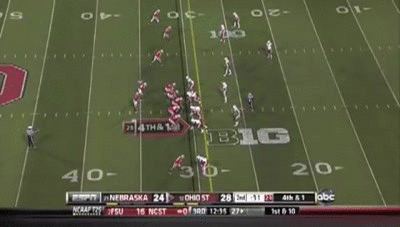
Meyer’s ultimate goal in any game is to run the ball between the tackles. He does this using a number of plays with a variety of designs.
Here is your typical inside zone-read play, in which the quarterback decides whether to hand off to the tailback based on the positioning of the defensive end:
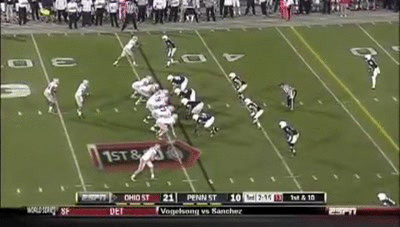
In this case, Miller waits for the end to commit inside before pulling the ball and scampering for a big gain outside.
Other base runs in Meyer’s scheme include the power:
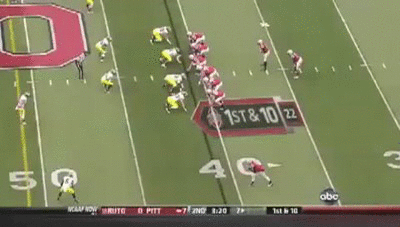
And the inverted veer, which differs from the zone read in that the quarterback carries up the middle as opposed to outside the tackles:
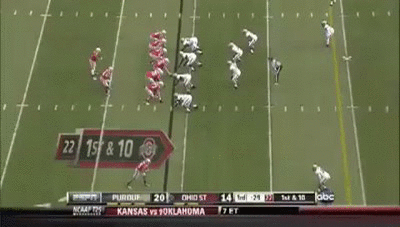
All those runs inside the tackles usually force the defense to overcompensate with extra defenders. When that happens, Meyer has “constraint” plays, which usually come in the form of bubble screens and play-action passes.
Here is a play that looks nearly identical to the inverted veer, so much so that the right guard even pulls to make the fake look more authentic. Illinois has seven guys in the box and gets burned for a touchdown down the left sideline.
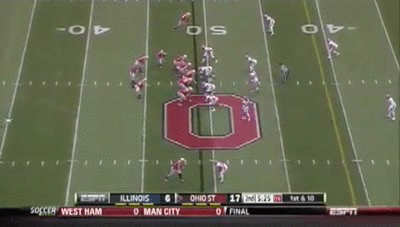
In this instance, Miller and the Buckeyes run a quick screen pass to the outside to take advantage of the outside linebacker who preemptively commits to the run:

These are the plays that open up holes between the tackles by making the defense respect the potential pass.
“We have a lot to be concerned with,” Edsall said.
Perhaps most alarming for the Terps is their track record against run-first quarterbacks. In a 34-20 win over Syracuse on Sept. 20, Edsall’s defense allowed Orange signal-caller Terrel Hunt to rush for 156 yards and two touchdowns.
Granted, that was without Farrand for most of the game. And the senior linebacker returned last week for the team’s 37-15 win at Indiana, making 19 tackles as part of an impressive defensive performance against running back Tevin Coleman and a productive Hoosiers rushing attack.
Meyer’s offense will provide a different challenge. But it’s one Farrand and the defense are more than willing to take on.
“Our confidence level is high. We know we can stop the run if everybody is doing their job,” Farrand said. “We proved that last week, and we’re hoping to prove it again this week.”



